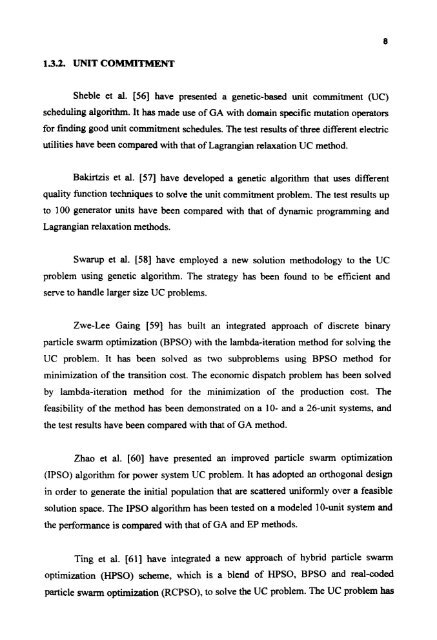performance evaluation of swarm intelligence based power system ...
performance evaluation of swarm intelligence based power system ...
performance evaluation of swarm intelligence based power system ...
Create successful ePaper yourself
Turn your PDF publications into a flip-book with our unique Google optimized e-Paper software.
13.2. UNIT COMMITMENTSheble et al. [56] have presented a genetic-<strong>based</strong> unit commitment (UC)scheduling algorithm. It has made use <strong>of</strong> GA with domain specific mutation operatorsfor finding good unit commitment schedules. The test results <strong>of</strong> three different electricutilities have been compared with that <strong>of</strong> Lagrangian relaxation UC method.Bakirtzis et al. [57] have developed a genetic algorithm that uses differentquality function techniques to solve the unit commitment problem. The test results upto 100 generator units have been compared with that <strong>of</strong> dynamic programming andLagrangian relaxation methods.Swarup et al. [58] have employed a new solution methodology to the UCproblem using genetic algorithm. The strategy has been found to be efficient andserve to handle larger size UC problems.Zwe-Lee Gaing 1591 has built an integrated approach <strong>of</strong> discrete binaryparticle <strong>swarm</strong> optimization (BPSO) with the lambda-iteration method for solving theUC problem. It has been solved as two subproblems using BPS0 method forminimization <strong>of</strong> the transition cost. The economic dispatch problem has been solvedby lambda-iteration method for the minimization <strong>of</strong> the production cost. Thefeasibility <strong>of</strong> the method has been demonstrated on a 10- and a 26-unit <strong>system</strong>s, andthe test results have been compared with that <strong>of</strong> GA method.Zhao et al. [60] have presented an improved particle <strong>swarm</strong> optimization(IPSO) algorithm for <strong>power</strong> <strong>system</strong> UC problem. It has adopted an orthogonal designin order to generate the initial population that are scattered uniformly over a feasiblesolution space. The IPSO algorithm has been tested on a modeled 10-unit <strong>system</strong> andthe <strong>performance</strong> is compared with that <strong>of</strong> GA and EP methods.Ting et al. [61] have integrated a new approach <strong>of</strong> hybrid particle <strong>swarm</strong>optimization (HPSO) scheme, which is a blend <strong>of</strong> HPSO, BPSO and real-codedparticle <strong>swarm</strong> optimization (RCPSO), to solve the UC problem. The UC problem has
















